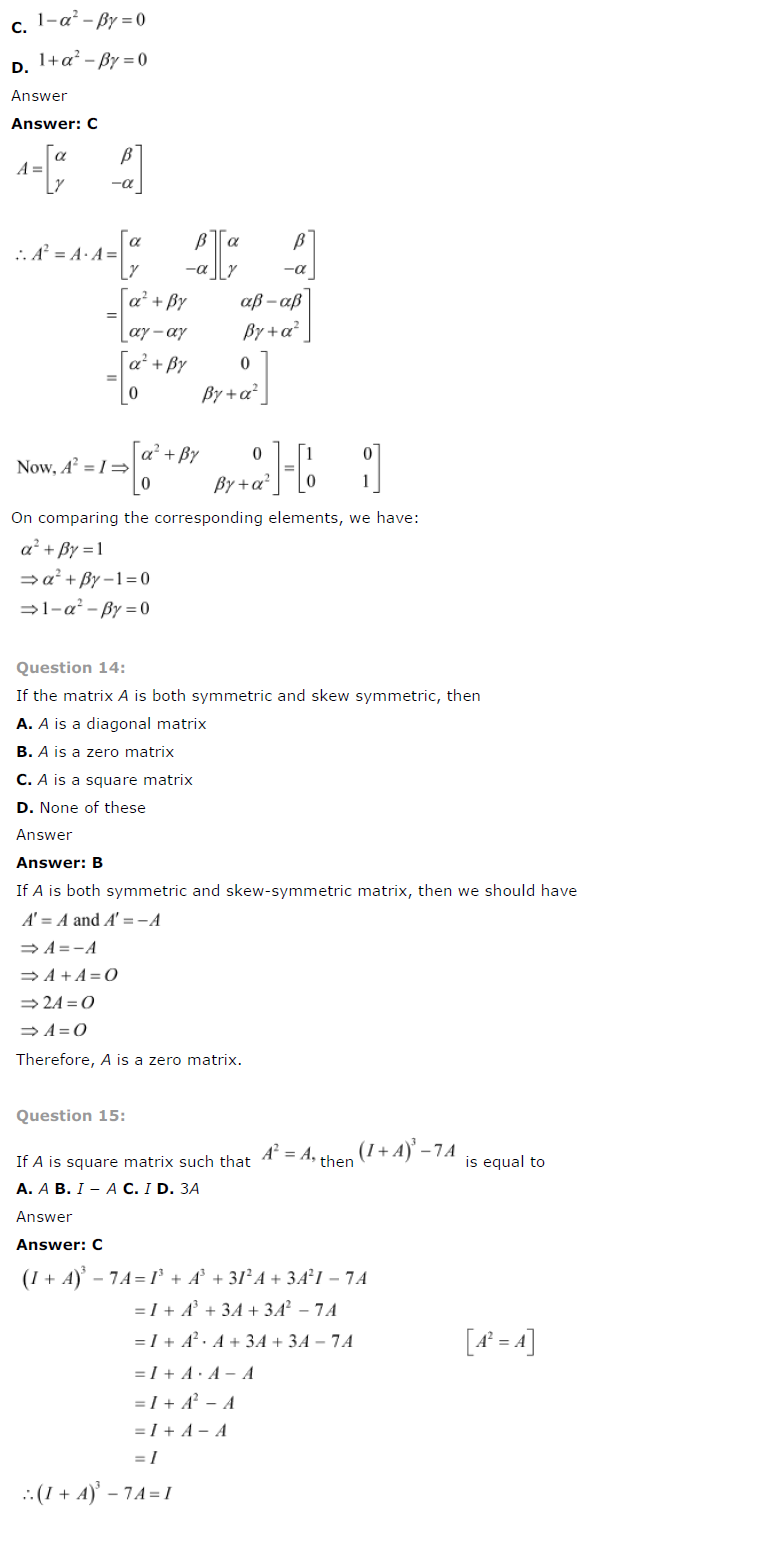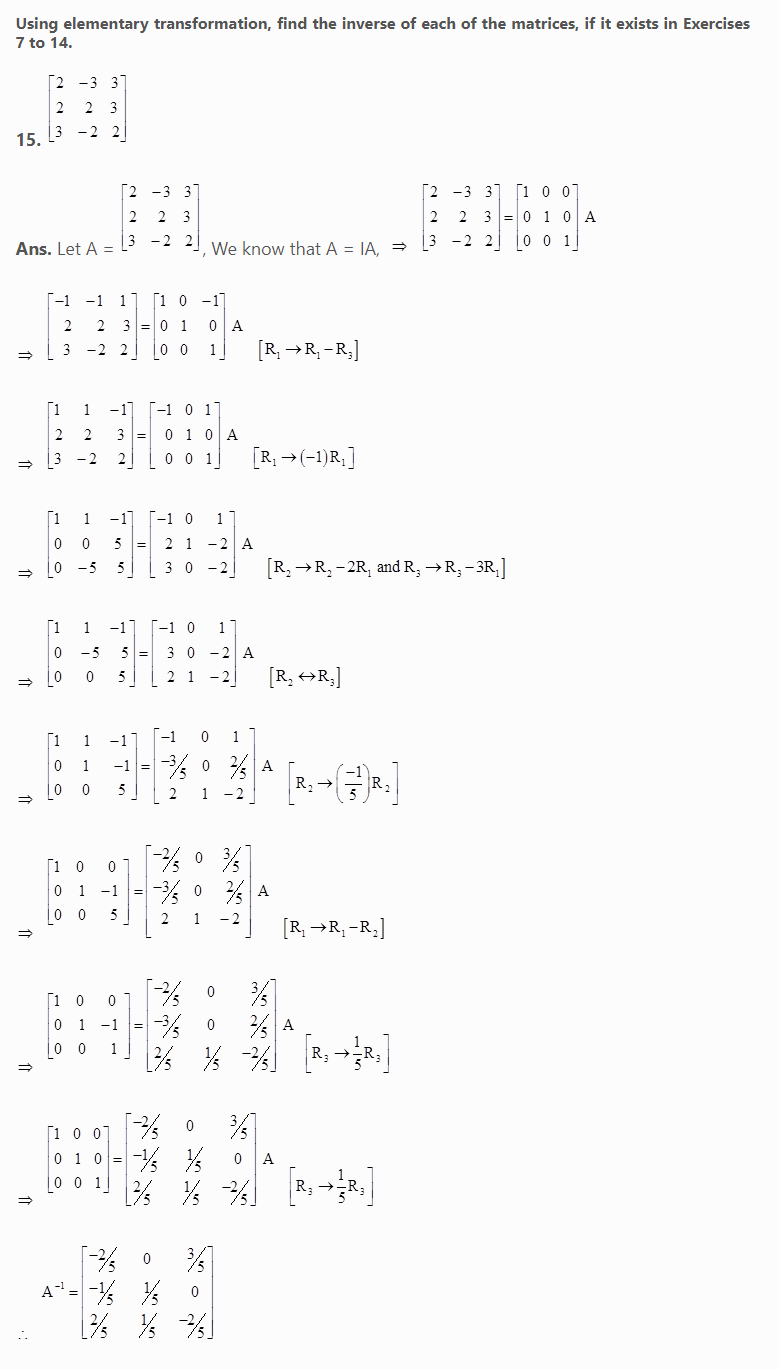
NCERT Solutions for Class 12 Maths Chapter 3 Matrices Free
NCERT Solutions for Class 12 Maths Chapter 3 Matrices are given by the expert teachers at BYJU’S. These solutions help the students to understand the concepts of the NCERT textbook for Chapter Matrices. BYJU’S provides detailed solutions for all NCERT questions to make students comfortable and confident of getting maximum marks. Class 12 Maths NCERT Solutions are solved by our Maths experts using a step by step approach, under the guidelines of NCERT, to assist students in their examination.
Matrices are one of the most powerful and essential tools in Mathematics. This Mathematical tool simplifies our work to a great extent when compared with other direct methods. The evolution of the concept of matrices is the result of an attempt to obtain short and simple ways of solving the system of linear equations. Matrices are used not only as a representation of the coefficients in a system of linear equations, but the use of matrices far exceeds just that application. Nowadays, this mathematical tool is not only used in certain branches of sciences but also in genetics, economics, sociology, modern psychology and industrial management. Coming to education, this topic is extremely important for both CBSE board exam and for competitive exams. Thus, students can practise these NCERT Solutions and improve their problem-solving skills.
Download PDF of NCERT Solutions for Class 12 Maths Chapter 3 Matrices
Access Answers of Maths NCERT Chapter 3 Matrices
NCERT Solutions for Class 12 Maths Chapter 3 Matrices
Class 12 Chapter 3 NCERT Solutions covers the following topics and subtopics. Students can practise problems on these topics and get ready for the exam with the help of BYJU’S NCERT Solutions For Class 12.
| s |














NCERT Solutions for Class 12 Maths Exercise 3.4 Q15

3.1 Introduction
In this chapter, students will be introduced to the fundamentals of matrix and matrix algebra. Here, students will learn how matrices are associated with different fields.
3.2 Matrix
3.2.1 Order of a matrix
In this section, it explains clearly with an easy example of how the elements are arranged to form a matrix and how its order can be defined.
3.3 Types of matrices
3.3.1 Equality of matrices
We shall discuss different types of matrices in this section such as column matrix, row matrix, square matrix, diagonal matrix, scalar matrix, identity matrix and zero matrices. Besides, equality of matrices is also explained with examples.
3.4 Operations on Matrices
3.4.1 Addition of matrices
3.4.2 Multiplication of a matrix by a scalar
3.4.3 Properties of matrix addition
3.4.4 Properties of scalar multiplication of a matrix
3.4.5 Multiplication of matrices
3.4.6 Properties of multiplication of matrices
After this section, students will get an idea on certain operations on matrices, namely, the addition of matrices, multiplication of a matrix by a scalar, difference, multiplication of matrices, and respective properties for each of these properties.
3.5 Transpose of a Matrix
3.5.1 Properties of the transpose of the matrices
Transpose of a matrix and properties are explained clearly with examples. These examples prove the properties of the transpose of a matrix.
3.6 Symmetric and Skew Symmetric Matrices
In this section, students will learn the definitions of symmetric and skew-symmetric matrices, along with the related theorems and examples.
3.7 Elementary Operation (Transformation) of a Matrix
After studying this section, students are able to understand transformations on a matrix. There are six operations, i.e. transformations on a matrix. Three of which are due to columns and three due to rows, which are known as elementary operations or transformations.
3.8 Invertible Matrices
3.8.1 Inverse of a matrix by elementary operations
Here, students will learn about the necessary conditions for matrices to have the inverse of them. Also, it has been discussed how to get an inverse matrix by performing elementary operations on the elements of a matrix.
Exercise 3.1 Solutions: 10 Questions (7 Short Answers, 3 MCQs)
Exercise 3.2 Solutions: 22 Questions (14 Long, 6 Short, 2 MCQs)
Exercise 3.3 Solutions: 12 Questions (10 Short Answers, 2 MCQs)
Exercise 3.4 Solutions: 18 Questions (4 Long, 13 Short, 1 MCQ)
Miscellaneous Exercise Solutions: 15 Questions (7 Long, 5 Short, 3 MCQs)
The solutions for NCERT questions provided by BYJU’S for Class 12 Maths Chapter 3 has covered all the below mentioned properties and formulas.
- An ordered rectangular array of numbers or functions is called a matrix.
- A matrix which has m rows and n columns is called a matrix of order m × n.
- [aij]m×1 is a column matrix.
- [aij]1×n is a row matrix.
- An m × n matrix is a square matrix if m=n.
- A = [aij]m×m is a diagonal matrix if aij=0, when i≠j.
- A = [aij]n×n is a scalar matrix if aij=0, when i≠j, aij=k (k is some constant), when i=j.
- A = [aij]n×n is an identity matrix if aij=1, when i=j, aij=0, when i≠j.
- A zero matrix has all its elements as zero.
- A = [aij] = [bij] = B if (i)A and B of the same order, (ii) aij = bij for all possible values of i and j.
- kA = k[aij]m×n = [k(aij)m×n]
- -A = (-1) A
- A – B = A + (-1) B
- A + B = B + A
- (A + B) + C = A + (B + C), where A, B and C are of the same order.
- k (A + B) = kA + kB, where A and B are of the same order, k is constant.
- (k + l) A = kA + lA, where k and l are constant.
